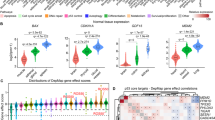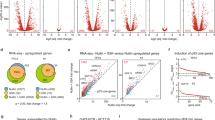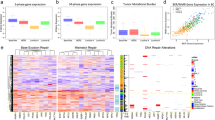Abstract
The tumor suppressor protein p53 regulates transcription of many genes that mediate cell cycle arrest, apoptosis, DNA repair and other cellular responses. Here we show that Ipaf, a human CED-4 homologue and an activator of caspase-1, is induced by p53. Overexpression of p53 by transfection in U2OS and A549 cells increased Ipaf mRNA levels. Treatment of p53-positive cell lines U2OS and MCF-7 with the DNA damaging drug, doxorubicin, which increases p53 protein level, induced expression of Ipaf mRNA but similar treatment of MCF-7-mp53 (a clone of MCF-7 cells expressing mutant p53) and p53-negative K562 cells showed much less induction of Ipaf gene expression. Expression analysis for Ipaf mRNA in doxorubicin-treated human tumor cell lines suggests that p53-dependent as well as p53-independent mechanisms are involved in the regulation of Ipaf gene expression in a cell-type-specific manner. The Ipaf promoter was activated by normal p53 but not by His273 mutant of p53. A functional p53-binding site was identified in the Ipaf promoter. A dominant-negative mutant of Ipaf inhibited p53-induced and doxorubicin-induced apoptosis by about 50%. Ipaf-directed small hairpin RNA downregulated p53-induced Ipaf gene expression and also reduced p53-induced apoptosis. Doxorubicin-induced apoptosis was also inhibited by Ipaf-directed small hairpin RNA. Our results show that p53 can directly induce Ipaf gene transcription, which contributes to p53-dependent apoptosis in at least some human cells.
This is a preview of subscription content, access via your institution
Access options
Subscribe to this journal
Receive 50 print issues and online access
$259.00 per year
only $5.18 per issue
Buy this article
- Purchase on SpringerLink
- Instant access to full article PDF
Prices may be subject to local taxes which are calculated during checkout








Similar content being viewed by others
References
Aurelio ON, Kong XT, Gupta S and Stanbridge EJ . (2000). Mol. Cell Biol., 20, 770–778.
Burns K, Martinon F and Tschopp J . (2003). Curr. Opin. Immunol., 15, 26–30.
Cryns V and Yuan J . (1998). Genes Dev., 12, 1551–1570.
Damiano JS, Stehlik C, Pio F, Godzic A and Reed JC . (2001). Genomics, 75, 77–83.
Degterev A, Boyce M and Yuan J . (2003). Oncogene, 22, 8543–8567.
Druilhe A, Srinivasula SM, Razmara M, Ahmed M and Alnemri ES . (2001). Cell Death Differ., 8, 649–657.
El-Deiry WS, Tokino T, Velculsscu VE, Levy DB, Parsons R, Trent JM, Lin D, Mercer WE, Kinzler KW and Vogelstein B . (1993). Cell, 75, 817–825.
Geddes BJ, Wang L, Huang WJ, Lavellee M, Manji GA, Brown M, Jurman M, Cao J, Morgenstern J, Merriam S, Glucksmann MA, Distefano PS and Bertin J . (2001). Biochem. Biophys. Res. Commun., 284, 77–82.
Gupta S, Radha V, Furukawa Y and Swarup G . (2001). J. Biol. Chem., 276, 10585–10588.
Gupta S, Radha V, Sudhakar Ch and Swarup G . (2002). FEBS Lett., 532, 61–66.
Gutierrez O, Pipaon C and Fernandez-Luna JL . (2004). FEBS Lett., 568, 79–82.
Han J, Flemington C, Houghton AB, Gu Z, Zambetti GP, Lutz RJ, Zhu L and Chittenden T . (2001). Proc. Natl. Acad. Sci. USA, 98, 11318–11323.
Hickman ES, Moroni MC and Helin K . (2002). Curr. Opin. Genet. and Dev., 12, 60–66.
Humke EW, Shriver SK, Starovasnik MA, Fairbrother WJ and Dixit VM . (2000). Cell, 103, 99–111.
Kamatkar S, Radha V, Nambirajan S, Reddy RS and Swarup G . (1996). J. Biol. Chem., 271, 26755–26761.
King AR, Francis SE, Bridgeman CJ, Bird H, Whyte MK and Crossman DC . (2003). Lab. Invest., 83, 1497–1508.
Lassus P, Opitz-Araya X and Lazebnik Y . (2002). Science, 297, 1352–1354.
Liedtke C, Groger N, Manns MP and Trautwein C . (2003). J. Biol. Chem., 278, 27593–27604.
Los M, Wesselborg S and Schulze-Osthoff K . (1999). Immunity, 10, 629–639.
MacLachlan TK and El-Deiry WS . (2002). Proc. Natl. Acad. Sci. USA, 99, 9492–9497.
Marsden VS, O’Conner L, O’Reilly LA, Silke J, Metcalf O, Ekert PG, Huang DCS, Cecconi F, Kuida K, Tomaselli KJ, Roy S, Nicholson DW, Vaux DL, Bouillet P, Adams JM and Strasser A . (2002). Nature, 419, 634–637.
Mariathasan S, Newton K, Monack DM, Vucic D, French DM, Lee WP, Roose-Girma M, Erickson S and Dixit VM . (2004). Nature, 430, 213–218.
Martinon F, Burns K and Tschopp J . (2002). Mol. Cell., 10, 417–426.
Masumoto J, Dowds TA, Schaner P, Chen FF, Ogura Y, Li M, Zhu L, Katsuyama T, Sagara J, Taniguchi S, Gumucio DL, Nunez and Inohara N . (2003). Biochem. Biophys. Res. Commun., 303, 69–73.
Matsuda M, Yoshida K, Taya Y, Nakamura K, Nakamura Y and Arakawa H . (2002). Cancer Res., 62, 2883–2889.
McLure KG and Lee PWK . (1998). EMBO J., 17, 3342–3350.
Moroni MC, Hickman ES, Caprara G, Denchi E, Colli E, Cecconi F, Muller H and Helin K . (2001). Nat. Cell Biol., 3, 552–558.
Nakano K and Vousden KH . (2001). Mol. Cell., 7, 683–694.
Poyet JL, Srinivasula SM, Tnani M, Razmara M, Fernandes-Alnemri T and Alnemri ES . (2001). J. Biol. Chem., 276, 28309–28313.
Radha V, Sudhakar Ch and Swarup G . (1999). FEBS Lett., 453, 308–312.
Sax JK and El-Deiry WS . (2003). Cell Death Differ., 10, 413–417.
Shivakrupa R, Radha V and Swarup G . (2003). J. Biol. Chem., 278, 52188–52194.
Srinivasula SM, Poyet JL, Razmara M, Datta P, Zhang ZJ and Alnemri ES . (2002). J. Biol. Chem., 277, 21119–21122.
Villunger A, Michalak EM, Coultas L, Mullauer F, Bock G, Ausserlechner MJ, Adams JM and Strasser A . (2003). Science, 302, 1036–1038.
Vogelstein B, Lane D and Levine AJ . (2000). Nature, 408, 307–310.
Vousden KH and Lu X . (2002). Nat. Rev. Cancer, 2, 594–604.
Yu JY, Deruiter SL and Turner DL . (2002). Proc. Natl. Acad. Sci. USA, 99, 6047–6052.
Yu J, Zhang L, Hwang PM, Kinzler KW and Vogelstein B . (2001). Mol. Cell., 7, 673–682.
Zhang WH, Wang X, Narayanan M, Zhang Y, Huo C, Reed JC and Friedlander RM . (2003). Proc. Natl. Acad. Sci. USA, 100, 16012–16017.
Zheng TS, Hunot S, Kuida K and Flavell RA . (1999). Cell Death Differ., 6, 1043–1053.
Acknowledgements
This work was supported by a grant from the Council of Scientific and Industrial Research, Government of India to GS. SS gratefully acknowledges the University Grants Commission, India for a senior research fellowship.
Author information
Authors and Affiliations
Corresponding author
Rights and permissions
About this article
Cite this article
Sadasivam, S., Gupta, S., Radha, V. et al. Caspase-1 activator Ipaf is a p53-inducible gene involved in apoptosis. Oncogene 24, 627–636 (2005). https://doi.org/10.1038/sj.onc.1208201
Received:
Revised:
Accepted:
Published:
Issue date:
DOI: https://doi.org/10.1038/sj.onc.1208201
Keywords
This article is cited by
-
Dynamic roles of inflammasomes in inflammatory tumor microenvironment
npj Precision Oncology (2021)
-
Inflammasomes and intestinal inflammation
Mucosal Immunology (2017)
-
Regulation of p73 by Hck through kinase-dependent and independent mechanisms
BMC Molecular Biology (2007)
-
Mechanism of ASC-mediated apoptosis: Bid-dependent apoptosis in type II cells
Oncogene (2007)



